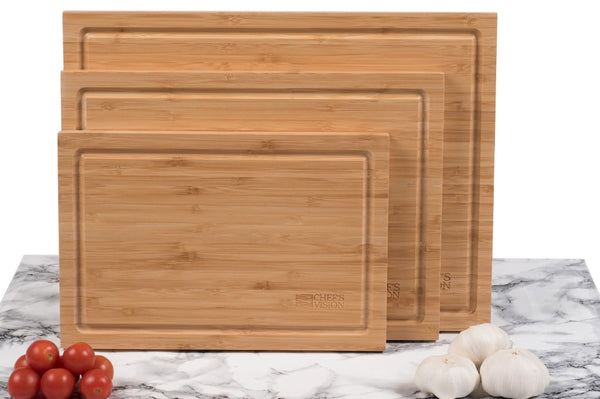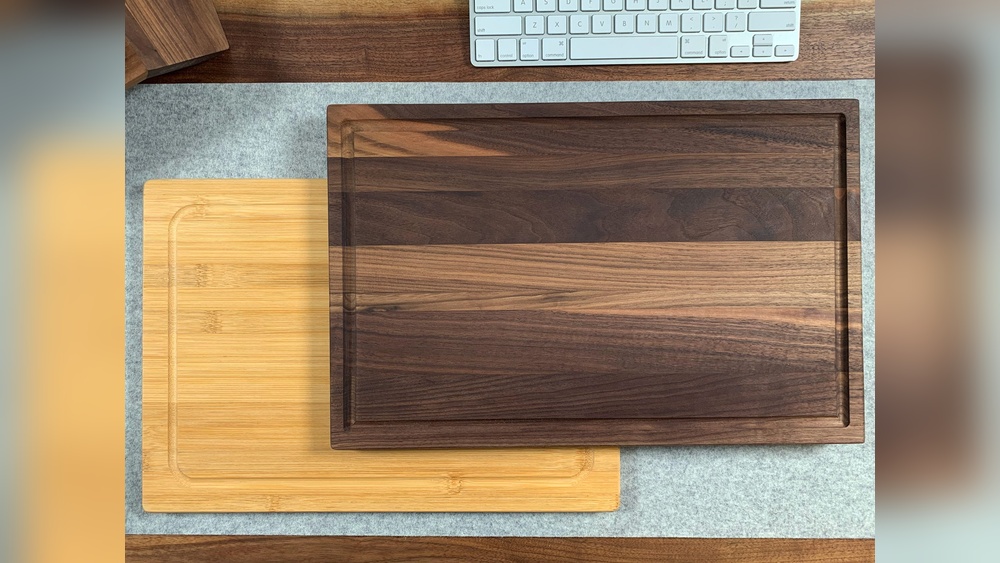When it comes to choosing the perfect cutting board for your kitchen, you might find yourself stuck between bamboo and wood options. Both look great and seem sturdy, but which one truly suits your cooking style and knife care needs?
Understanding the difference between bamboo and wood cutting boards can save you from dull knives, hygiene headaches, and extra maintenance work. You’ll discover the key features, pros, and cons of each type so you can pick the one that fits your kitchen and keeps your food preparation safe and efficient.
Ready to find out which cutting board is best for you? Let’s dive in!

Credit: chefsvisionknives.com
Material Differences
The material differences between bamboo and wood cutting boards affect their use and care. Understanding these differences helps you choose the right board for your kitchen needs. Bamboo and wood vary in origin, composition, density, and hardness. These factors influence durability, knife friendliness, and maintenance.
Origin And Composition
Bamboo is a fast-growing grass, not a tree. It grows in tall, hollow stalks. Bamboo boards are made by compressing many thin strips together. These strips are glued with adhesives to form a solid surface.
Wood cutting boards come from various tree species. Common woods include maple, walnut, and cherry. Each type has unique grain patterns and natural oils. Wood boards are usually made from a single piece or several joined pieces of hardwood.
Density And Hardness
Bamboo is denser and harder than many hardwoods. This density makes bamboo cutting boards resistant to cuts and scratches. The hardness can dull knives faster, requiring more frequent sharpening.
Wood boards vary in hardness depending on the species. Softer woods like pine are easy on knives but less durable. Hardwoods like maple offer a good balance of durability and knife care. Wood’s natural grain can help hide knife marks better than bamboo.

Credit: chefsvisionknives.com
Knife Impact
The impact of cutting boards on your knives plays a crucial role in kitchen efficiency. Bamboo and wood cutting boards differ significantly in how they affect knife blades. Understanding these differences helps preserve your knives and improve your cooking experience.
Effect On Knife Sharpness
Bamboo boards are harder than most wood boards. This hardness can dull knives faster. Knives lose their sharp edge quicker when used on bamboo. Wood boards offer a softer surface. They allow knives to stay sharp longer. Using wood boards reduces the need for frequent sharpening.
Silica Content And Abrasion
Bamboo contains a high amount of silica. Silica is a natural abrasive material. This abrasive nature wears down knife edges faster. The silica in bamboo scratches the blade more than wood does. Wood boards have less silica, causing less abrasion. This makes wood gentler on knives over time.
Hygiene Factors
Hygiene is a key factor in choosing between bamboo and wood cutting boards. Both materials have unique traits that affect cleanliness. Understanding these differences helps keep your kitchen safe.
Porosity And Bacteria Retention
Bamboo is more porous than many hardwoods. This means it can absorb liquids faster. Bacteria may hide inside these tiny pores. Wood boards tend to have tighter grain, reducing absorption. Proper cleaning is essential for both types. Regular washing and drying prevent bacteria buildup.
Splinter Issues
Bamboo cutting boards can develop fuzzy splinters over time. These small fibers may stick to food, which is unsafe. Wood boards usually show fewer splinters if maintained well. Sanding and oiling wood boards keep surfaces smooth. Check bamboo boards often to avoid splinter risks.
Adhesive Safety
Many bamboo boards are made from glued strips. Some adhesives might not be food-safe. Chemicals can leach into food if low-quality glue is used. Wood boards are often solid pieces, reducing this risk. Choose bamboo boards that clearly state food-safe adhesives. This ensures safer food contact.
Maintenance Needs
Maintaining bamboo and wood cutting boards requires different approaches. Both materials need care to stay clean and last longer. Understanding these needs helps keep your boards safe and in good shape.
Cleaning Guidelines
Bamboo boards should be washed by hand with warm, soapy water. Avoid soaking them to prevent warping or cracking. Wood boards also need gentle hand washing. Use a soft sponge and mild soap. Rinse quickly and dry immediately with a towel.
Oiling And Care
Bamboo cutting boards need regular oiling to stop drying and splitting. Use food-safe mineral oil or beeswax. Apply oil once a month or when the board looks dry. Wood boards also benefit from oiling. This keeps the surface smooth and reduces water absorption. Oiling wood boards every few weeks maintains their strength and appearance.
Dishwasher Suitability
Neither bamboo nor wood cutting boards are safe for dishwashers. High heat and water can damage both materials. Bamboo boards may crack or warp easily in a dishwasher. Wood boards can also swell, crack, or lose finish. Hand washing is the best way to keep both types in good condition.
Durability And Longevity
Durability and longevity are key factors in choosing a cutting board. Both bamboo and wood boards offer strong performance but differ in how they hold up over time. Understanding these differences helps in picking the right board for your kitchen needs.
Resistance To Cracking And Warping
Bamboo is known for its hardness and density. This makes it less likely to crack under pressure. However, bamboo can warp if exposed to too much moisture or heat. Wood cutting boards, especially those made from hardwoods like maple or walnut, resist warping well. Wood is more flexible, which helps it handle changes in humidity better than bamboo. Both types need proper care to avoid damage.
Wear Over Time
Bamboo wears differently than wood. Its hard surface can dull knives faster because of its silica content. Over time, bamboo may develop small splinters or rough spots. Wood boards usually show knife marks, but these do not affect performance and can be sanded out. Wood also absorbs oils better, which helps maintain its surface. Regular oiling extends the life of both bamboo and wood boards, preventing cracks and dryness.
Environmental Impact
The environmental impact of cutting boards matters to many buyers today. Choosing between bamboo and wood involves thinking about how each affects nature. Both materials come from plants, but they grow and are harvested differently. This difference shapes their sustainability and carbon footprints. Understanding these factors helps make greener choices for kitchens.
Sustainability Of Bamboo
Bamboo grows very fast, much faster than most trees. It can reach full size in just a few years. This rapid growth means bamboo can be harvested often without damaging the ecosystem. Bamboo also regrows from its roots, so cutting it does not kill the plant. This reduces soil erosion and keeps the land healthy.
Because bamboo needs less water and no pesticides, it is eco-friendly to grow. It captures carbon dioxide efficiently, helping fight climate change. Bamboo products often have a smaller carbon footprint than wood from slow-growing trees.
Wood Sourcing Considerations
Wood cutting boards come from various types of trees. Some trees take decades or even centuries to mature. Harvesting these trees too quickly can lead to deforestation and habitat loss. Sustainable wood comes from forests managed to allow new trees to grow after cutting.
Look for certifications like FSC (Forest Stewardship Council) when choosing wood. These labels show the wood was sourced responsibly. Wood forests also help clean air and water and support wildlife. However, not all wood cutting boards come from sustainable forests, so check carefully.
Cost And Availability
Cost and availability play a big role in choosing between bamboo and wood cutting boards. Both options offer different price points and access levels. Understanding these differences helps you pick the best board for your kitchen and budget.
Price Comparison
Bamboo cutting boards usually cost less than wood ones. Bamboo grows fast, so it is cheaper to produce. Wood boards, especially hardwood like maple or walnut, tend to be more expensive. The price rises with quality and brand. Bamboo offers a budget-friendly option without sacrificing durability. Wood boards are often seen as an investment due to their long lifespan and classic look.
Market Accessibility
Bamboo boards are widely available in many stores and online. Their growing popularity makes them easy to find in different sizes and styles. Wood cutting boards are also common but may be limited by region and type of wood. Specialty wood boards might require shopping at kitchen stores or ordering online. Both types have good market presence, but bamboo has a slight edge in everyday accessibility.

Credit: chefsvisionknives.com
Use Cases And Preferences
Choosing between bamboo and wood cutting boards depends on how you use them and what you prefer in the kitchen. Each material offers unique benefits for different tasks. Understanding these use cases helps you pick the right board for your cooking style.
Best For Heavy-duty Cutting
Wood cutting boards are excellent for heavy-duty chopping. Their dense fibers absorb impact well, protecting your knives. They handle forceful cutting, like chopping bones or thick vegetables, without damage.
Wood boards also resist deep cuts, reducing bacteria buildup. They last longer under heavy use with proper care. Bamboo boards are harder but more brittle, which can dull knives faster during tough chopping.
Lightweight And Portable Options
Bamboo cutting boards are lighter and easier to move around the kitchen. They are ideal for quick prep tasks and small kitchens. Their firm surface is great for slicing fruits, bread, and herbs.
Bamboo’s natural resistance to moisture makes it less likely to warp when carried or stored. Wood boards tend to be heavier and bulkier, which can be less convenient for portable use or outdoor cooking.
Frequently Asked Questions
What Are The Disadvantages Of Bamboo Cutting Boards?
Bamboo cutting boards dull knives quickly due to hardness and silica. They require regular oiling and cannot go in dishwashers. Their porous surface may harbor bacteria if not cleaned well. Splinters can form, and some adhesives might contain harmful chemicals.
Are Wood Cutting Boards Better Than Bamboo Cutting Boards?
Wood cutting boards are gentler on knives and less porous, reducing bacteria risk. Bamboo is harder, dulls knives faster, and needs more care. Wood often lasts longer with proper maintenance. Choose based on knife care and cleaning preferences for best results.
What Is The Healthiest Type Of Cutting Board To Use?
The healthiest cutting boards are hardwoods like maple or teak. They resist bacteria, are gentle on knives, and last long with proper care. Avoid porous or glued boards like bamboo that can harbor bacteria and damage knives. Regular cleaning and oiling ensure safety and durability.
Is A Bamboo Cutting Board Ok For Meat?
Bamboo cutting boards are suitable for meat if cleaned and maintained properly. They resist moisture but can dull knives faster. Regular oiling and thorough sanitizing prevent bacteria buildup. Avoid dishwasher use to prevent warping or cracking. Choose food-safe glue boards to ensure safety.
Conclusion
Choosing between bamboo and wood cutting boards depends on your needs. Bamboo is harder and may dull knives faster. Wood is softer and gentler on blades. Bamboo can develop splinters and needs regular oiling. Wood requires maintenance but is less likely to splinter.
Both need proper cleaning to stay safe and last longer. Think about knife care, hygiene, and upkeep before deciding. Each board has strengths and weaknesses. Pick the one that fits your kitchen habits best. Simple care keeps either board working well for years.

